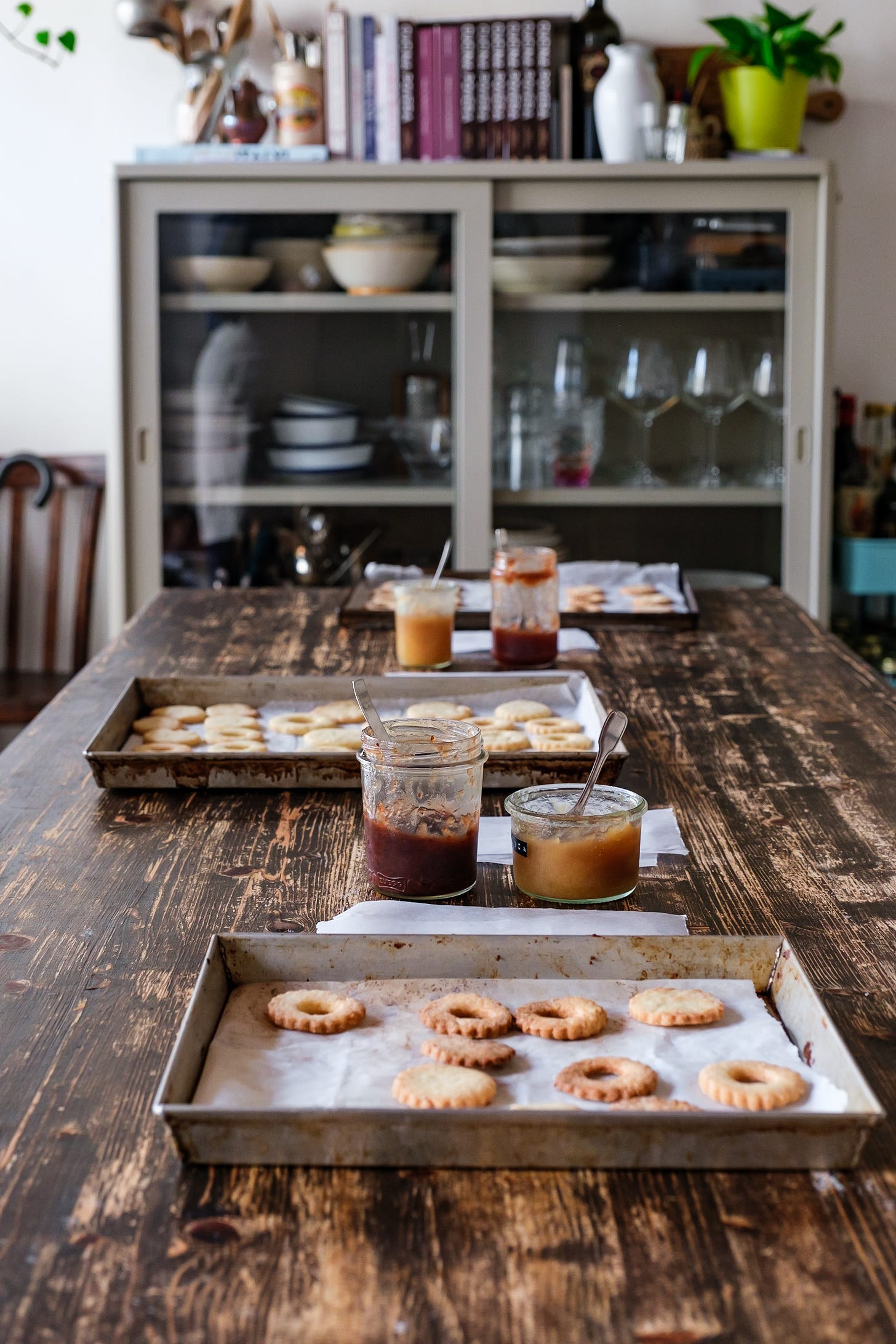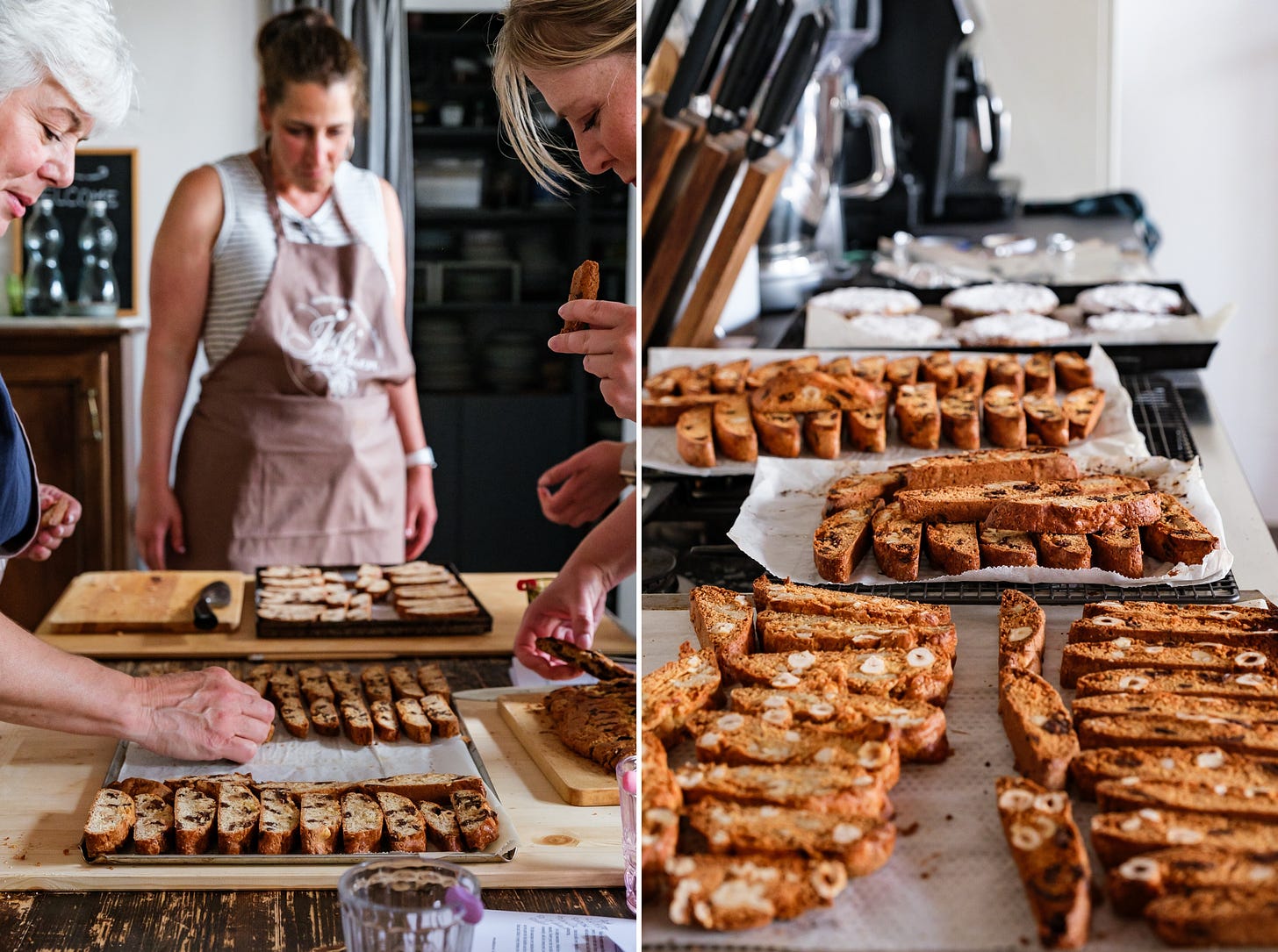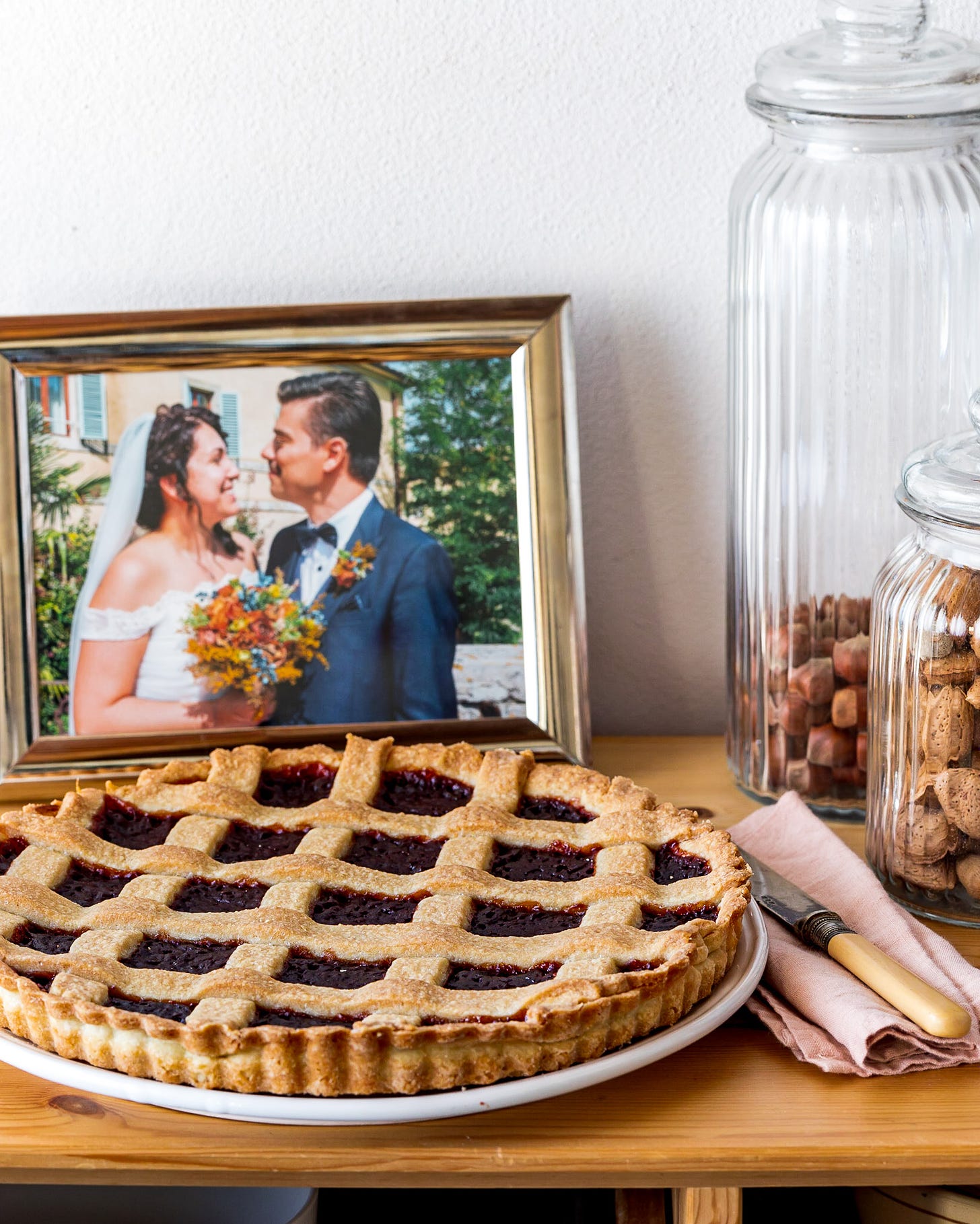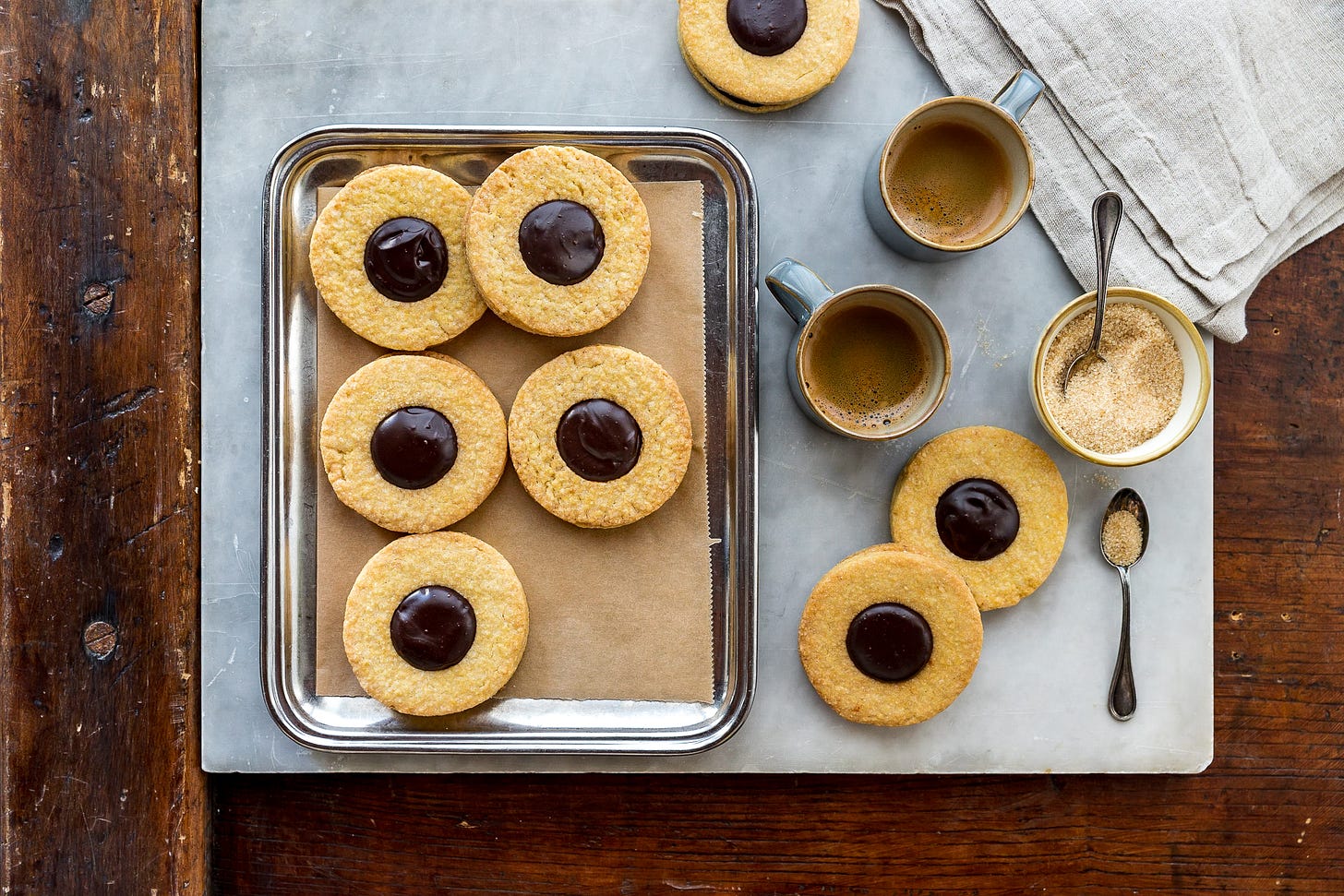All about pasta frolla, the Italian buttery shortcrust dough
Plus a recipe to make occhi di bue, Italian sandwich cookies with jam
This is an exclusive recipe for the subscribers. It is part of a serialized Tuscan cookbook that you will receive over the course of one year, a collection of tested classic Tuscan recipes to add to your cooking repertoire. Learn more about the I Love Toscana project here and find all the recipes here. You can upgrade and get access to this, as well as all our monthly cook-along and live talks, on the link above.
I’m back to everyday life after two weeks spent in a kitchen that smelled of butter, honey, and spices, surrounded by the smiling, heartwarming company of the people I met during the eight baking classes I taught for Bake From Scratch. I lived for days in a vanilla, sugary cloud, speaking of the strength of flour, the best aroma to choose for pasta frolla, the texture of a well-baked panforte, and the perfect timing to soak ladyfingers in alchermes to make zuppa inglese.
I’m a home cook, and I am also a home baker, someone who loves nothing more than one-bowl cakes, imperfect cookies, and rustic jam tarts. My baking style is simple, familiar, and unpretentious. I love natural aromas—citrus zest, herbs, vanilla—, forgiving doughs, and all those recipes you can make with pantry staples.
There’s a definition in Italian that collects all these humble cakes: torte da credenza.
These are cakes that were meant to be kept on the dining room sideboard, closed into the glass display cabinet where our grandmas would store china, crystal, linens, and serving dishes. Kept at room temperature outside of the fridge (or, better, before that every household had a fridge), torte da credenza are made with simple, pantry staples—flour, sugar, eggs—, with no filling, no pastry cream or whipped cream. Though, they could include jams, fruit, nuts, and chocolate. Think about apple cakes, ciambellone, pound cakes, jam tarts, nut biscotti, sponge cakes, carrot cakes…
They have this humble, unpretentious look, and often remind you of your childhood, of those cakes your mum or nonna would bake for breakfast, or as a quick afternoon snack. It’s like comfort food, but applied to baked goods.
Expect more examples of torte da credenza in the next months, and have ready some space on your dining room sideboard, or on your countertop, for all the cakes and cookies we will bake together in the upcoming months.
Here you can already find a few examples of torte da credenza:
Buckwheat cake from Alto Adige, rustic and dense, with a thick layer of redcurrant jam, you can serve it with a side of barely sweetened whipped cream.
Persimmon cake. Bake it for afternoon tea, or enjoy it for breakfast with a mug of dark coffee.
Apple olive oil cake. The quest for the perfect apple cake is like searching for the Holy Grail: infinite, legendary, epic, and exciting. Each season brings new ideas, scents and textures.
Yoghurt pound cake for breakfast. This yoghurt pound cake was born from the classic recipe for pound cake. You can find an extensive post on the blog all about pound cake if you are interested in understanding how it works and how you can play with the ingredients. Read it here.
Coffee and extra virgin olive oil cake. It calls for very simple ingredients, from your pantry. It has the scent and flavour of a time-past cake, one your grandmother would make, to keep in her kitchen cupboard.
Kneading, baking, and eating so much pasta frolla—an Italian buttery shortcrust dough—during my Bake from Scratch classes made me realize how much I love it, how versatile it is, and how you can manage it to make it suitable also for the warmer season. So I thought I would start my journey in the wonderful world of torte da credenza with pasta frolla, and everything you can do with it.
All about pasta frolla
This rich, buttery Italian shortcrust pastry is a staple in the repertoires of fine pastry chefs and family home cooks alike. In the home kitchen, the versatile dough is the starting point for many humble, reliable recipes, from simple shortbread cookies to rustic jam-filled crostatas.
The meaning of its name is interesting to note. “Pasta” refers to “pastry,” while “frolla” comes from the verb “frollare,” which, when applied to meat, means to hang it, to let it age and mature.
The same should be done with pasta frolla. Make it in advance and let it rest in the fridge for at least a few hours, or better overnight. Allowed to rest, the dough, crumbly when first made, will become more compact and elastic, making it much easier to roll out with a rolling pin.
This is just the first stage of maturing, though; the second comes after the pastry is baked. A good general rule is to wait a few hours, or even better until the next day, to eat any pastries made with pasta frolla. Your patience will be rewarded with the perfect crisp, delicately crumbly texture, and you’ll find that the flavour of the pastry will have harmoniously melded with its fillings or toppings.
Basic Ingredients
There are endless recipes for pasta frolla, varying based on their geographical origins, their use (to make a cookie, a jam crostata, or a delicate pastry), or simply the preferences of the individual pastry chef. The core ingredients remain basically the same; what changes from recipe to recipe is their proportions.
Eggs
Eggs are essential, adding richness to the dough. Some recipes call for only the yolks, others for only the whites, and yet others for whole eggs or a combination of whole eggs and yolks. In any case, use regular-sized eggs.
Butter…
In Italy, we tend to use unsalted butter for pasta frolla, as salted butter is less common in our supermarkets and deli shops. Sometimes, though, if I find a stick of imported demi-sel French butter, I use that instead: it immediately makes my homely pasta frolla feel fancier, giving it a more complex flavour that contrasts beautifully with a sweet jam.
The butter should be softened, but still cold when you mix it into your dough. We call the perfect consistency “in pomata,” meaning that it has the texture of a gel or pomade. This makes the butter much easier to rub into the flour.
You can soften a stick of butter without melting it by pounding it, still wrapped, with a rolling pin, or directly on your countertop (it works magnificently also as a natural anti-stress). Once it is in pomata, cube the butter to use in the pasta frolla.
… or Lard
In older recipes, as in two of the variations of pasta frolla shared by Italian writer Pellegrino Artusi in his legendary 1891 cookbook “Science in the Kitchen and the Art of Eating Well,” you’ll find lard used as the starring fat, instead of butter. Lard can substitute for butter completely, or just in part.
Today, lard is still very common in pasta frolla recipes from the South of Italy—for example, in the crust of a pastiera from Naples, a traditional Easter cake filled with ricotta, boiled wheat berries, and candied citrus peel; or in the pasticciotti of Puglia, small pastries made with a delicate shell of pasta frolla and a heart of thick, aromatic pastry cream.
Flour
Achieving pasta frolla’s characteristic texture starts with the flour, which needs to be low in gluten. Use an all-purpose flour or cake flour, as long as it is not self-rising. I’ve also used whole wheat flour and farro flour with very good results.
To prevent the development of gluten in your dough, rub the flour and sugar together with the butter first, so as to coat the flour completely with a thin, protective film of fat. You are aiming for a texture that resembles grated Parmigiano Reggiano. Then add the eggs, which will help you bring the coarse crumbs together into a cohesive ball of dough.
Sugar
Experiment with different varieties of sugar: the finer the sugar, the more delicate the pasta frolla. Confectioners’ sugar results in a fine, melt-in-your-mouth texture, while caster or granulated sugar produces a crumblier pastry. Try also raw or unrefined cane sugar, especially when making cookies, for a crunchy, rustic texture.
Flavourings
You can flavour your pasta frolla according to the filling or other ingredients you plan to pair with the pastry.
Grated orange or lemon zest adds brightness, freshness, and a delicate citrusy note. I find it a perfect addition to cookies, especially during Christmastime. Be sure to choose organic citrus fruits for zesting.
Dried spices such as cinnamon, cardamom, and nutmeg give a more distinct character to pasta frolla. Let your taste guide you, and experiment with your favourite spices.
I usually prefer not to use real vanilla seeds in pasta frolla, as they lose some of their fragrance when baked. If I want a vanilla-flavoured dessert, I instead add the flavour to the filling or opt for my vanilla sugar (every time I use a vanilla pod, even for a custard, I rinse it, dry it, and stick it into my sugar jar).
My friend Emanuela, my favourite pastry chef and the one that taught me more about baking, often uses loose tea leaves in her pasta frolla, with outstanding results.
The best season for pasta frolla
Cooler months are definitely better than summer months pasta frolla, when you can easily over-knead the dough, resulting in a sticky, melting dough.
My tips, if you want to make pasta frolla in the summer, are these:
Make it in the early morning or late evening, and not in an overheated kitchen.
Once ready, let it rest in the fridge overnight before preparing your tart or cookies. A second rest in the fridge before baking could help the tart or cookies retain their shape.
If there are dough scraps, you can knead them again, but it’s better if you rest the dough in the fridge once more before rolling it out.
The following is just one of the many recipes you can choose to make pasta frolla, the one I’ve been following since I was a child, the one my mum and grandma would make every time we wanted to have crostata for dessert.
You can use this pasta frolla to make:
a 12-inch/30cm jam tart (find my favourite recipe in Cucina Povera, p. 277) - oh, and the BIG NEWS is that the book is finally available also in Europe, you can find all the online shops here.
RECIPE - Occhi di Bue
Occhi di bue, literally ox eyes, are the largest shortcrust cookies, a reassuring constant in any pastry shop, café, or bakery counter in Italy. They are perfect in their generous round shape, winking from the counter with their heart of jam or chocolate.









